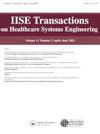智能远程分类和个性化路由,以管理患者访问神经外科诊所
IF 1.5
Q3 HEALTH CARE SCIENCES & SERVICES
IISE Transactions on Healthcare Systems Engineering
Pub Date : 2021-04-26
DOI:10.1080/24725579.2021.1921081
引用次数: 3
摘要
摘要:我们考虑神经外科诊所新腰痛(LBP)患者的入院过程,以管理患者通过个性化路径策略改善就诊延迟的需求,而不是增加护理能力。利用首次预约的临床记录,我们设计了一个基于决策树的智能远程分诊工具,非医学训练的代理可以使用它来预测打电话请求预约的患者的手术类别。智能远程分类工具基于一个分类器,该分类器使用我们使用结构化算法和特征生成的手术-非手术标签,这些标签很容易在电话交谈过程中直接从患者那里获得。我们确定,远程分类工具的准确性是在80%的订单使用10倍交叉验证和样本外测试的真实数据集。然后,我们提出了三种基于优先级的路由策略,这些策略在护理能力方面是中立的,并表明,当与智能分诊工具结合使用时,这些策略可以使应该紧急就诊的高优先级手术患者的访问延迟减少90%。我们使用约会调度工作流的详细模拟来演示我们的结果。我们评论了我们工作的管理意义,以及使用基于需求的个性化路由策略和智能远程分诊的潜力,以减少访问延迟,改善患者结果和提供者满意度。本文章由计算机程序翻译,如有差异,请以英文原文为准。
Intelligent teletriage and personalized routing to manage patient access in a neurosurgery clinic
Abstract We consider the intake process of new low back pain (LBP) patients at a neurosurgery clinic to manage patient demand for improving access delays through personalized routing strategies rather than increasing care capacity. Using clinical notes from the first appointments with providers, we devise a decision-tree based intelligent teletriage tool that can be used by non-medically trained agents to predict the surgical class of a patient calling in to request an appointment. The intelligent teletriage tool is based on a classifier that uses surgical-nonsurgical labels that we have generated using a structured algorithm and features that are easy to obtain directly from the patient during the course of a phone conversation. We establish that the accuracy of the teletriage tool is in the order of 80% using 10-fold cross validation and out-of-sample testing on real-life data sets. We then present three priority-based routing strategies that are neutral with respect to care capacity, and show that when used in combination with the intelligent triage tool, these can result in 90% reduction in access delays for the higher priority surgical patients who should be seen urgently. We use detailed simulations of the appointment scheduling workflow to demonstrate our results. We comment on the managerial implications of our work and the potential for the use of needs-based personalized routing strategies with intelligent teletriage to reduce access delays, improve patient outcomes and provider satisfaction.
求助全文
通过发布文献求助,成功后即可免费获取论文全文。
去求助
来源期刊

IISE Transactions on Healthcare Systems Engineering
Social Sciences-Safety Research
CiteScore
3.10
自引率
0.00%
发文量
19
期刊介绍:
IISE Transactions on Healthcare Systems Engineering aims to foster the healthcare systems community by publishing high quality papers that have a strong methodological focus and direct applicability to healthcare systems. Published quarterly, the journal supports research that explores: · Healthcare Operations Management · Medical Decision Making · Socio-Technical Systems Analysis related to healthcare · Quality Engineering · Healthcare Informatics · Healthcare Policy We are looking forward to accepting submissions that document the development and use of industrial and systems engineering tools and techniques including: · Healthcare operations research · Healthcare statistics · Healthcare information systems · Healthcare work measurement · Human factors/ergonomics applied to healthcare systems Research that explores the integration of these tools and techniques with those from other engineering and medical disciplines are also featured. We encourage the submission of clinical notes, or practice notes, to show the impact of contributions that will be published. We also encourage authors to collect an impact statement from their clinical partners to show the impact of research in the clinical practices.
 求助内容:
求助内容: 应助结果提醒方式:
应助结果提醒方式:


